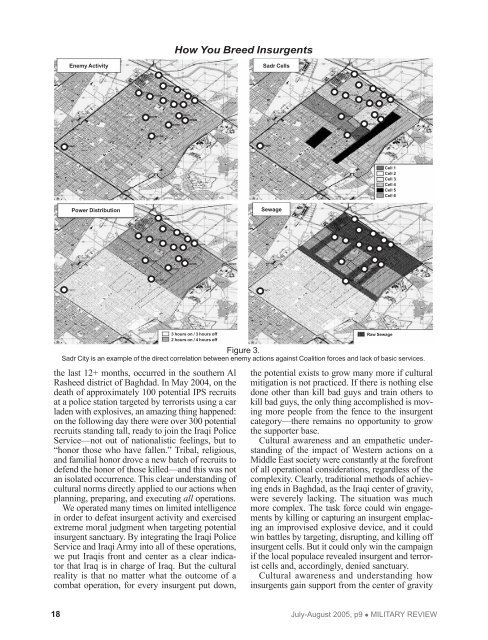Counterinsurgency Reader - Combined Arms Center - U.S. Army
Counterinsurgency Reader - Combined Arms Center - U.S. Army
Counterinsurgency Reader - Combined Arms Center - U.S. Army
You also want an ePaper? Increase the reach of your titles
YUMPU automatically turns print PDFs into web optimized ePapers that Google loves.
How You Breed Insurgents<br />
Enemy Activity<br />
Sadr Cells<br />
Cell 1<br />
Cell 2<br />
Cell 3<br />
Cell 4<br />
Cell 5<br />
Cell 6<br />
Power Distribution<br />
Sewage<br />
3 hours on / 3 hours off<br />
2 hours on / 4 hours off<br />
Figure 3.<br />
Sadr City is an example of the direct correlation between enemy actions against Coalition forces and lack of basic services.<br />
the last 12+ months, occurred in the southern Al<br />
Rasheed district of Baghdad. In May 2004, on the<br />
death of approximately 100 potential IPS recruits<br />
at a police station targeted by terrorists using a car<br />
laden with explosives, an amazing thing happened:<br />
on the following day there were over 300 potential<br />
recruits standing tall, ready to join the Iraqi Police<br />
Service—not out of nationalistic feelings, but to<br />
“honor those who have fallen.” Tribal, religious,<br />
and familial honor drove a new batch of recruits to<br />
defend the honor of those killed—and this was not<br />
an isolated occurrence. This clear understanding of<br />
cultural norms directly applied to our actions when<br />
planning, preparing, and executing all operations.<br />
We operated many times on limited intelligence<br />
in order to defeat insurgent activity and exercised<br />
extreme moral judgment when targeting potential<br />
insurgent sanctuary. By integrating the Iraqi Police<br />
Service and Iraqi <strong>Army</strong> into all of these operations,<br />
we put Iraqis front and center as a clear indicator<br />
that Iraq is in charge of Iraq. But the cultural<br />
reality is that no matter what the outcome of a<br />
combat operation, for every insurgent put down,<br />
Raw Sewage<br />
the potential exists to grow many more if cultural<br />
mitigation is not practiced. If there is nothing else<br />
done other than kill bad guys and train others to<br />
kill bad guys, the only thing accomplished is moving<br />
more people from the fence to the insurgent<br />
category—there remains no opportunity to grow<br />
the supporter base.<br />
Cultural awareness and an empathetic understanding<br />
of the impact of Western actions on a<br />
Middle East society were constantly at the forefront<br />
of all operational considerations, regardless of the<br />
complexity. Clearly, traditional methods of achieving<br />
ends in Baghdad, as the Iraqi center of gravity,<br />
were severely lacking. The situation was much<br />
more complex. The task force could win engagements<br />
by killing or capturing an insurgent emplacing<br />
an improvised explosive device, and it could<br />
win battles by targeting, disrupting, and killing off<br />
insurgent cells. But it could only win the campaign<br />
if the local populace revealed insurgent and terrorist<br />
cells and, accordingly, denied sanctuary.<br />
Cultural awareness and understanding how<br />
insurgents gain support from the center of gravity<br />
18<br />
July-August 2005, p9 • Military Review

















